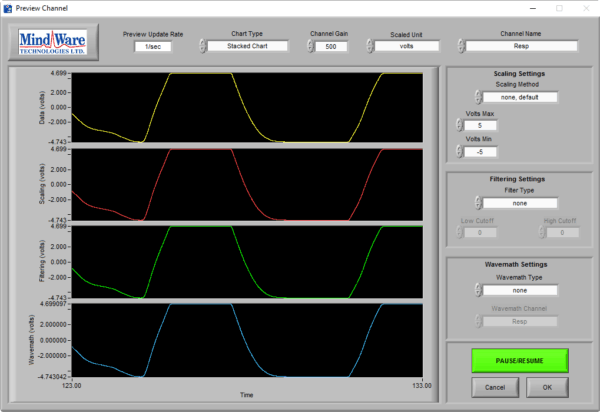Below are the recommended starting gain values for different BioNex modules when collecting different signal types. It is always important to preview your data to ensure the gain setting is appropriate.
If gain is set too high, the waveform will appear suddenly flat across the top or bottom of the graph as the amplitude nears +/-5 volts.
Impedance Cardiograph & GSC
| Channel Name | Gain | Notes |
| ECG | 500 | N/A |
| Z0 | N/A | Gain is fixed with a scaling of 0.1 volts/ohm |
| dZ/dt | N/A | Gain is fixed with a scaling of 1 volts/ohm/sec |
| GSC | 1st Generation – 10
2nd Generation – 50 |
To identify the generation of your module, see this support article. |
Impedance Cardiograph & GSC 2
| Channel Name | Gain | Notes |
| ECG | 500 | N/A |
| Z0 | N/A | Gain is fixed with a scaling of 0.1 volts/ohm |
| dZ/dt | N/A | Gain is fixed with a scaling of 1 volts/ohm/sec |
| GSC | N/A | Gain is fixed with a scaling of 10 uS/volt |
3 Channel Bio & GSC
| Channel Name | Signal Type | Gain | Notes |
| Bio 1-3* | ECG | 500 | N/A |
| Respiration | 100 | Using a respiration belt | |
| Facial EMG | 2000 | Zygomaticus, Corrugator, Obicularis, etc | |
| Large Muscle EMG | 500 | Bicep, Quadricep, etc. | |
| GSC | 1st Generation – 10
2nd Generation – 50 |
To identify the generation of your module, see this support article. |
* All Bio channels are the same, and therefore have the same gain recommendations
4 Channel Bio & GSC
| Channel Name | Signal Type | Gain | Notes |
| Bio 1-4* | ECG | 500 | N/A |
| Respiration | 100 | N/A | |
| Facial EMG | 2000 | Zygomaticus, Corrugator, Obicularis, etc | |
| Large Muscle EMG | 500 | Bicep, Quadricep, etc. |
* All Bio channels are the same, and therefore have the same gain recommendations
4-Channel Transducer
| Channel Name | Signal Type | Gain | Notes |
| Channel 1* | Finger PLE | 100 | |
| Ear PLE | 500 | ||
| Respiration | 100 | ||
| Skin Temperature | 50 | Requires modified Transducer module | |
| Continuous Blood Pressure | 100 | CNAP | |
| Accelerometer | 50 | ||
| Activity Sensor | 100 | ||
| Hand Dynamometer | 500 |
* All Transducer channels are the same (with the exception of a modified Skin Temp channel), and therefore have the same gain recommendations

